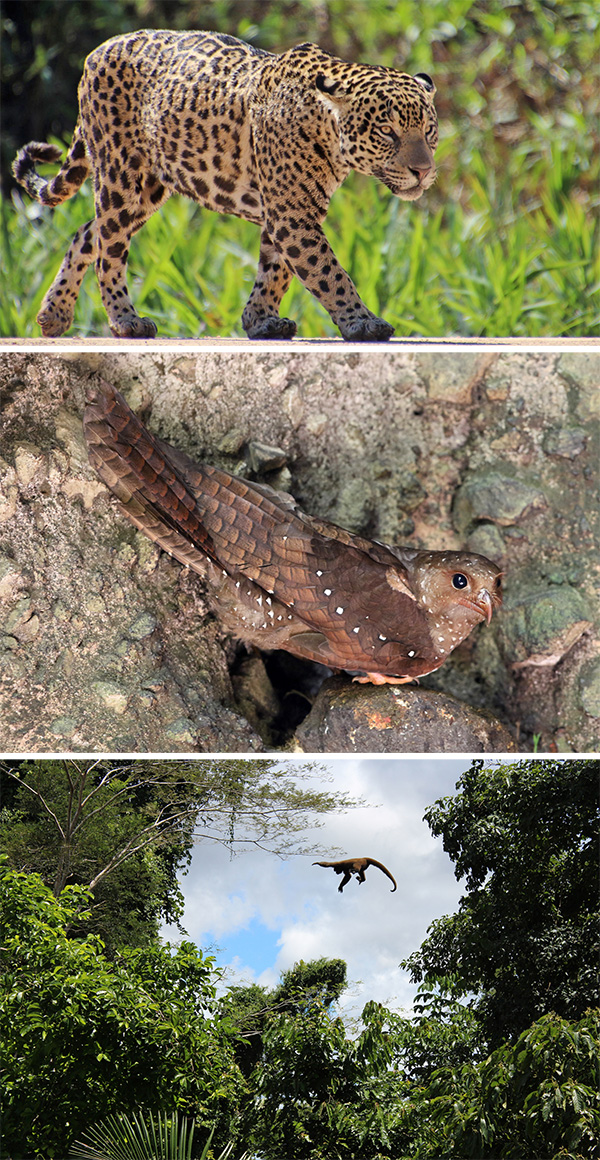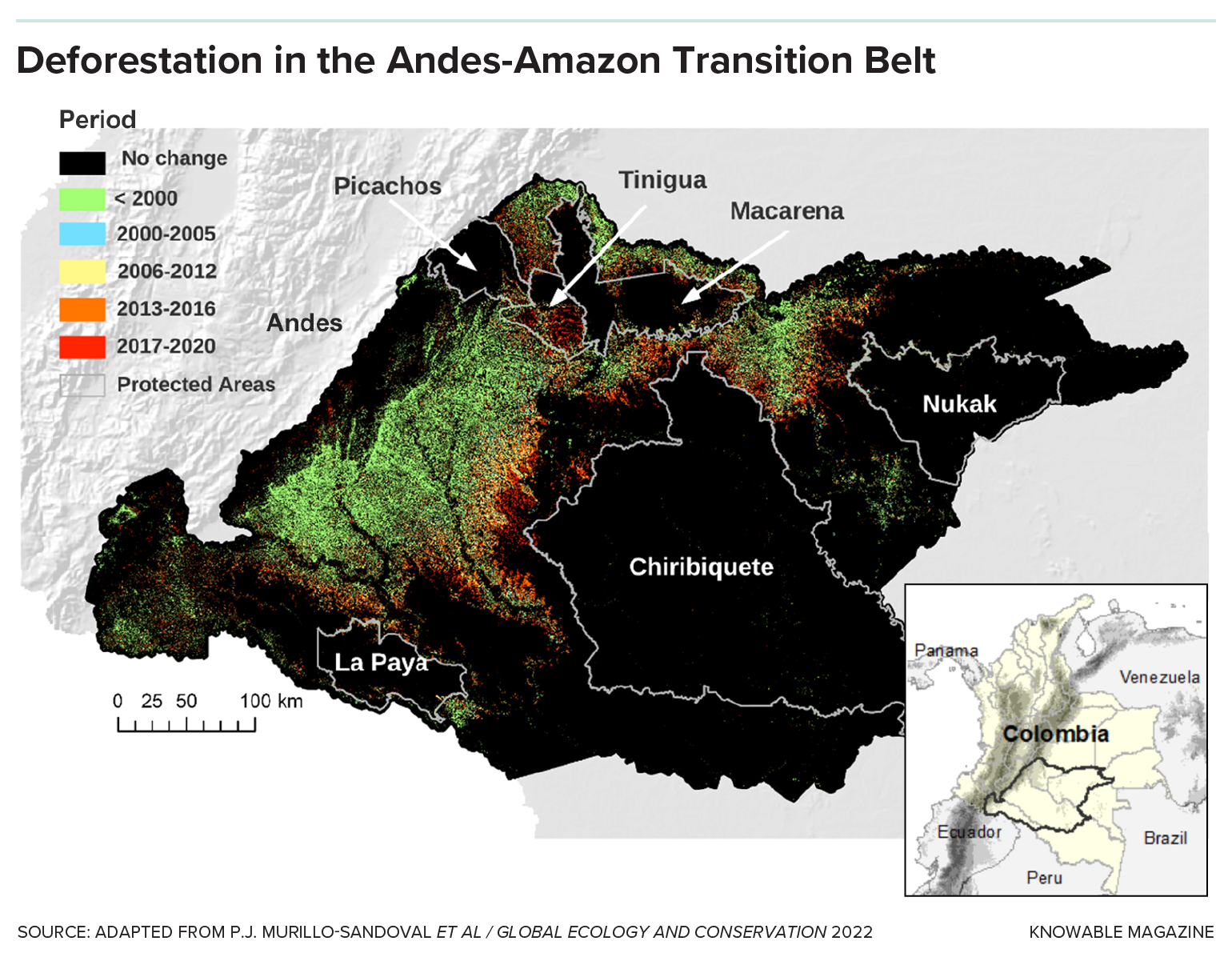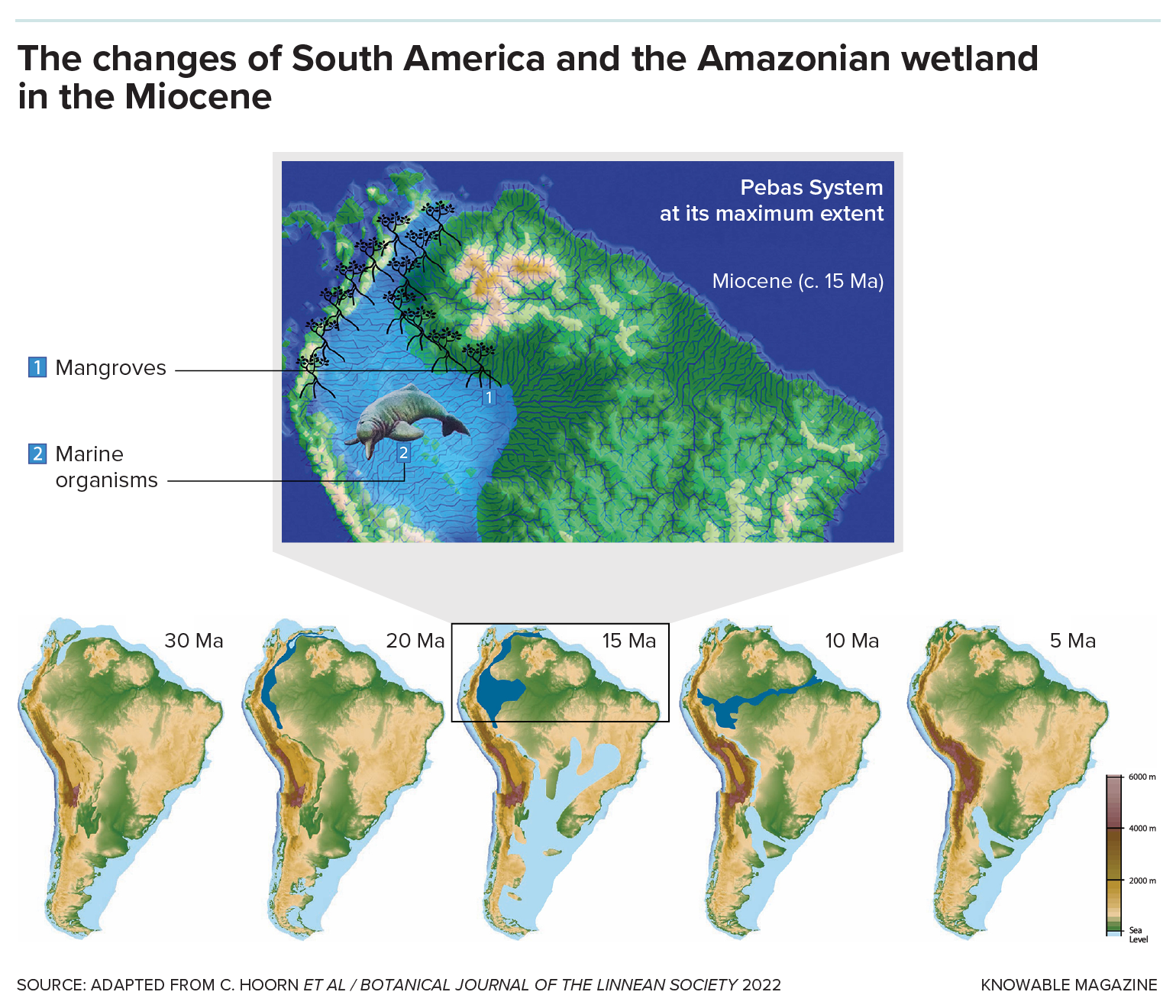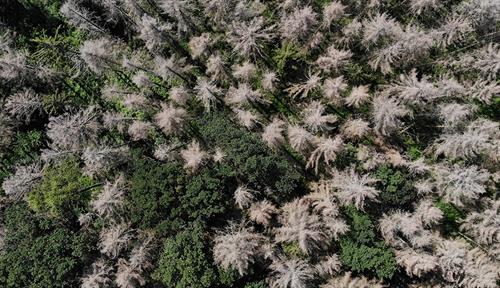Losing the connection between the Andes and the Amazon: A price of peace in Colombia
The South American country, where the biodiversity of the Andes meets that of the Amazon, is losing the great natural wealth of some 1,500 square kilometers of forest each year, mainly in areas formerly under guerrilla control
Support sound science and smart stories
Help us make scientific knowledge accessible to all
Donate today
In 2016, the same year the Colombian government and guerrillas of the Revolutionary Armed Forces of Colombia (FARC) agreed to end a war that had lasted almost half a century, the forests that make northwestern South America one of the most biodiverse places on the planet began to vanish. The demise of a conflict that had claimed the lives of at least 450,664 people marked the beginning of an environmental tragedy: In 2016 alone, deforestation increased 44 percent over the previous year.
“Colombia is now experiencing the consequences of the power vacuum left by the FARC over large parts of its territory,” warned ecologist Nicola Clerici of the University of Rosario in Bogota and colleagues in 2018. For decades, the war had slowed colonization in the south of the country and impeded deforestation — a phenomenon termed “gunpoint conservation.” After the peace agreement, the dynamics changed.
Colombia is now losing an average of 1,500 square kilometers of forest each year, an area 25 times the size of the island of Manhattan. About 65 percent of this is Amazonian forest. The forests are replaced by land for cattle ranching and agriculture, or they are simply set on fire so that the land can be fenced and sold. In 2018 alone, fires in biodiversity hotspots increased sixfold over the previous year.
Most of this deforestation is concentrated in the areas formerly controlled by the FARC, which include a 500-kilometer-long strip of land where the foothills of the Andes Mountains and the Amazon lowlands meet — a place that is a passageway for thousands of species, an area for genetic exchange between different populations of the same species, and a region supporting an extensive network of rivers that flow down from the mountains to feed the Amazon basin.
Beyond deforestation: the loss of connectivity
So far, political, media and even scientific attention and concern, both in Colombia and globally, has focused on the deforestation that is advancing in the Amazon itself. But Clerici and his colleagues, geographer Paulo Murillo of the University of Tolima in Ibagué and ecologist Camilo Correa-Ayram of the Pontifical Javierian University in Bogotá, are trying to draw attention to the problem that largely goes unnoticed: Deforestation is causing the loss of ecological connectivity between Andean and Amazonian forests.
The consequences of interrupting a biodiversity highway that has operated since the start of the Miocene, some 23 million years ago, are unknown, says Correa-Ayram. “We need to know what future trajectory this phenomenon is going to take,” he says.

The jaguar, the guácharo and the woolly monkey are three of thousands of species that are being affected by the fragmentation of their habitat and the loss of connection between Andean and Amazonian forests.
CREDITS FROM TOP: MILLIE BASDEN, CHRISTOPH MONING, MICHAEL A. ALCORN / iNATURALIST.ORG
The three scientists set out to analyze the extent of the loss of connectivity — the degree to which terrain impedes the movement of species between patches of resources — in forest areas in the Andes-Amazon Transition Belt, as the region is known. When ecosystems maintain high connectivity, animal species can freely feed, reproduce and migrate, as well as cycle nutrients, pollinate plants and disperse plant seeds.
The researchers used an index to estimate the spatial and functional connectivity between different forest patches — a measure they term “connected habitat.” Traditionally, analyses calculate only habitat loss, which oversimplifies ecosystem health. Think of a city’s power grid: It is one thing to lose power in 20 percent of the city and quite another to have that 20 percent loss concentrated in hospitals, railway operations and other crucial centers. In a similar manner, integrating variables like spatial patterns of lost habitat and the ability of species to continue to move around provides a better diagnosis of habitat health.
The findings, published in Global Ecology and Conservation in 2022, reported that the loss of habitat in the Colombian Andes-Amazon region between 2000 and 2020 was 13 percent, while the loss of connected habitat was higher still, at 18 percent. Both deforestation and connected habitat loss have accelerated since 2016, coinciding with the end of the armed conflict. “This result is worrisome because it indicates that well-connected patches are more fragmented and isolated, affecting the natural connections between the Andes and Amazon biogeographical regions and the movement ability of species,” the authors wrote.

Uninterrupted connections between the Andean and Amazonian ecosystems in Colombia are currently maintained only through a path formed by the Picachos, Tinigua and Macarena national parks; and to the south, along a corridor that includes the La Paya park. This map shows deforestation in the Andes-Amazon Transition Belt over time. The areas in black represent conserved forest; the boundaries of six protected areas are shown within them, marked with white lines. The colored area marks the deforestation arc between the Andes and the Amazon.
This is bad news for the woolly monkey (Lagothrix lagothricha), which eats more than 200 types of plants and, like the Colombians, has learned to adapt to, and live in, a wide range of temperatures, from the hot lowland Amazonian rainforests to the cold Andean cloud forests. The loss of connected habitat will greatly restrict and fragment its home.
It is bad news also for guácharos (Steatornis caripensis), birds that travel at night from caves in the Andes mountains to the Amazon forests in search of a variety of fruits; it will mean longer journeys or changes to their diets. And for jaguars, which travel hundreds of kilometers back and forth between the Amazon and Andes forests in search of mates or food. And similarly for each of the thousands of species that live in the region.
Distances as small as four meters — such as those created by roads or power lines — are enough to become territorial barriers for some species, write ecosystem scientist Yadvinder Malhi of the University of Oxford and colleagues in an article in the Annual Review of Environment and Resources, in which they describe the human-caused factors currently affecting tropical forests.
A look into the past
Understanding the importance of this connection between the Andes and the Amazon requires a trip back in time to answer a question: Why is northwest South America one of the most biodiverse places on the planet?
“What we know is that the Amazon and the Andes Mountains are very interconnected, and the great diversity we see in the western Amazon is due to that interaction,” says Carina Hoorn, a geologist and paleoecologist at the University of Amsterdam, who traveled to Caquetá in southern Colombia, one of the most deforested areas of the country, to complete her master’s thesis in the 1980s. Hoorn has combined information from different fields — molecular biology, palynology, geology and phylogenetics — to try to understand the origin of biodiversity in the Amazon, a story in which the Andes played a leading role.
The story begins with a monumental collision between tectonic plates, mainly the South American plate and the Nazca plate, which gave rise to the majestic Andes Mountains. During the same era in which the dinosaurs became extinct, the end of the Cretaceous — about 100 million to 66 million years ago — these plates began to collide (Hoorn often compares them to two Mars bars squeezing against each other). It was an epic event, but in slow motion: Tectonic plates advance at an average speed of 1.5 centimeters per year. As they crashed and rode over each other, they caused folding in the crust that formed the mountains.
The southern part of the Andes, in present-day Argentina and Chile, and the center, in present-day Bolivia and Peru, formed first. The northern part, which corresponds to Ecuador and Colombia, began to rise some 23 million years ago and also involved interaction with the Caribbean tectonic plate. At this time, northern South America was a vast wetland known as the Pebas System, composed of deep lakes and swamps connected to the Caribbean Sea, as Hoorn and coauthors describe in the 2023 Annual Review of Earth and Planetary Sciences.
When the Andean mountains reached a critical elevation of more than 2,000 meters (more than 6,500 feet), they began to drastically alter the regional climate as rainfall increased — which coincided with a drop in global sea level. More rain and rivers rolling down the mountains meant more erosion and more washing of sediments and nutrients into the lowlands, into the Amazon. These sediments formed the basis for an explosion of diversity on the western side of the Amazon.

During the Miocene Epoch, the geography of South America changed drastically. The rise of the Andes led to the transformation of the ancient Pebas System — a wetland encompassing northern South America — into the Amazon River basin, as shown in a series of maps. The top image shows a reconstruction of the Pebas System at its maximum extent during the high sea level of the mid-Miocene. At that time, the area was inhabited by coastal mangroves and marine organisms.
The Andes altered the entire landscape of northern South America. The ancient Pebas System was transformed into the Amazon River. The reorganization of the tectonic plates also caused the closure of the isthmus of Panama about 3.5 million years ago, leading to the Great Biotic American Exchange, in which previously isolated species migrated from the north to the south, and vice versa.
“To understand the Amazon, you have to understand the Andes-Amazon relationship,” Hoorn stresses. In terms of plants alone, it is estimated that the Amazon rainforest harbors some 50,000 species. And the Andes, occupying only 0.6 percent of the Earth’s surface, is home to 10 percent of the world’s vascular plant diversity — some 30,000 species. “The Andean mountains played a pivotal role in generating the biodiversity that colonized various regions of the Neotropics,” write Oscar Alejandro Pérez, an evolutionary biologist at the Royal Botanic Gardens, Kew, in England and his colleagues, in an article published in Trends in Plant Science.
Rethinking conservation strategies
Everything that happens in the Andes ends up affecting the rest of the Amazon ecosystem, biologist Dolors Armenteras Pascual often tells her students at the National University of Colombia, where she is director of the Landscape Ecology and Ecosystem Modeling research group.
Armenteras Pascual regrets that there is not enough local research and information to better understand these phenomena and rethink conservation strategies. “We need more local research to effectively understand what is going on,” she says. “If we don’t do that, we can’t give evidence-based policy recommendations.”
After several decades studying the effects of deforestation, she has recently become focused on the need to better understand effects on aquatic systems. Most of the sediments that provide vital nitrogen, phosphorus and other elements to the Amazon come down from the Andes, she notes. “They have to do with the primary productivity of the whole basin, with phytoplankton, fish, dolphins, you name it. Any disconnection between the Andes and the Amazon also implies that this aquatic system is destabilized,” she says.
Pablo Negret, a Colombian ecologist at the University of Bern, Switzerland, agrees that the connection between the Andes and the Amazon is extremely important. One of the research projects he is involved in aims to identify which areas in the Andes-Amazon Transition Belt should be prioritized for conservation. “Globally, protected areas are biased towards areas of little economic interest,” he says. If you say you are protecting a giant area of the Amazon, “everyone applauds you, but if you go and measure, the impact is almost null because in that place there is less pressure from deforestation.” Investing money in protecting an area where colonization is advancing can be more costly, Negret acknowledges, but it is also more effective in preserving forest and species biodiversity.
Erle Ellis, an environmental scientist at the University of Maryland and author of a review of human land use published in the 2021 Annual Review of Environment and Resources, adds another concern to this list: In the face of climate change, species are trying to adapt by moving to different habitats. “Almost all species have a need to move on a large scale. And in that situation, connectivity is even more important,” he says. But, he argues, the way ecoregions, and therefore protected areas, have been mapped by the authorities does not allow them to be modified as the climate changes.
With such concerns in mind, researchers have begun to focus on analyses that can help policymakers redefine their conservation and restoration priorities.
One example of this is a study conducted by Correa-Ayram, spatial data analyst Daniela Linero and ecologist Jorge Velásquez and published in late 2023. They analyzed which corridors linking national parks in Colombia would ensure better connectivity to support 26 species of forest-dependent birds.
The data showed that, by protecting 212,551 square kilometers of land between various protected areas — mostly in the Andean and Amazonian forests — and by investing in efforts to restore 79,203 square kilometers currently used for agriculture, Colombia’s forest cover would increase by 7 percent and connectivity by 14 percent.
However, 82 percent of those 79,203 square kilometers identified as high-priority patches of land to be restored are not being considered in current plans. “The reflection here is how to move from words to deeds,” says Correa-Ayram. “We have a number of scientific studies, but where is the implementation of the corridors?”
For Correa-Ayram, the challenge in the coming years will be to achieve other types of connectivity: one between what science says and what policy should do, and another with the communities that live in these territories, so that they are active participants in the efforts to save one of the most biodiverse corners of the planet.
Article translated by Debbie Ponchner
10.1146/knowable-022224-1
TAKE A DEEPER DIVE | Explore Related Scholarly Articles






